HTC One vs HTC One Mini
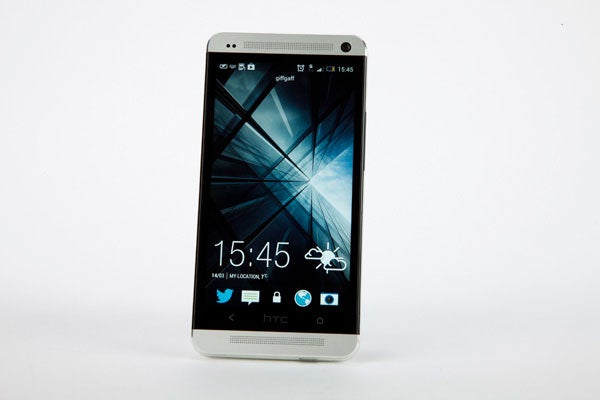
The HTC One is our favourite high-end phone of the year so far. And now it has a little brother, the HTC One Mini.
But is this really a miniature version of the best Android phone money can buy? Let’s compare the two.
HTC One vs HTC One Mini – Video Comparison
Don’t fancy poring
over a load of text? We’ve produced a little video that compares the HTC
One and HTC One Mini side-by-side. Give it a watch.
HTC One vs HTC One Mini – Design
HTC One – Aluminium, ‘hidden’ plastic sides, 9.3mm thick, 143g
HTC One Mini – Aluminium, plastic sides, 9.25mm thick, 122g
They may be based on the same core design, but there’s an important difference or two between the HTC One and the HTC One Mini. Primarily, there’s a lot more plastic on show in the Mini version.
In the HTC One, plastic is reserved for the inside parts of the phone’s sides, recessed within the aluminium frame of the device. This means that you’ll only really feel the metal of the HTC One when in-hand – the plastic is there for the look as much as anything else.
With the HTC One Mini, the white plastic that covers the whole of the phone’s edges is far more obvious. It acts as a plastic ‘bumper’ that sticks out a little way from the aluminium frame.
The HTC One Mini is also significantly smaller. It’s 5mm less wide, and 5mm shorter – something worth considering if you have smaller hands.
There’s marginal difference in the thickness, though, sharing a curved metal rear that doesn’t worry too much about providing an eye-catching thinness ‘spec’.
Both phones come in black and silver shades, but the full-size HTC One also comes in dazzling red. It’s not a muted red, either, but a rich blood red. Bold? Absolutely? Beautiful? Yes, maybe it is.
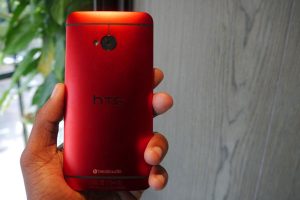
HTC One vs HTC One Mini – Screen
HTC One – 4.7-inch 1080p LCD-3 screen
HTC One Mini – 4.3-inch 720p Super LCD-3 screen
They may be brothers, but the screens of the HTC One and One Mini are quite different, technologically-speaking. They use different resolutions and different screen sizes.
Resolution is the biggest separating factor here. The HTC One has a 1080p screen, the One Mini a 720p display. Although it’s bigger, this gives the HTC One far better pixel density – 469ppi, next to 341 ppi in the Mini.
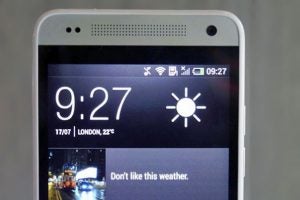
The One Mini screen, up-close
Before we get carried away, both these figures are very high. The ‘Retina’ display of the iPhone 4, which got this whole high pixel-density resolution off the ground, was 326ppi.
Both screens are very sharp, but the HTC One has that extra level of immaculate rendering of text.
Next, on to panels. Both phone use the Super LCD-3 type. This is a very similar to the IPS screen type – an LCD-based display that has excellent viewing angles.
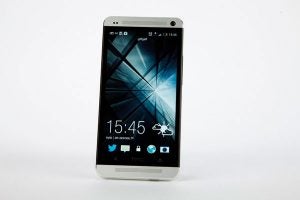
During the launch of the HTC One X, which used a Super LCD-2 screen, HTC claimed that the display type matched IPS. It just couldn’t be called IPS for licensing reasons.
General display quality is very similar to the HTC One, with excellent brightness and contrast. It’s only the resolution that lags far behind.
The last difference is the most obvious one – the HTC One screen is bigger than the Mini’s. However, the difference may not be quite as huge as you might initially assume.
The HTC One Mini’s screen is 4.3 inches across. A year or so ago this would have seemed large, but now it’s fit to be called ‘mini’. The HTC One screen is a 4.7-incher, accounting for the extra size of the phone.
When watching movies, we’d much rather use the full-size HTC One. However, for day-to-day usage, the HTC One Mini screen is easily big and sharp enough to satisfy.
HTC One vs HTC One Mini – Software
HTC One – Android with HTC Sense
HTC One Mini – Android with HTC Sense
Both One-series phones use Android 4.2 and the new HTC Sense UI, which was introduced alongside the HTC One. It gives Android the distinct HTC look, which these days is based around BlinkFeed.
BlinkFeed is a widget that takes up a whole screen and gives you a feed of your latest updates, plus a clock. It takes its updates from social networks and your favourite sites – you can customise what it displays.
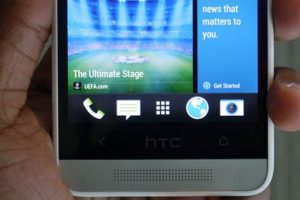
A look at the Sense shortcut bar
Aside from this rather dynamic Android alteration, Sense just tries to keep Android looking good. It doesn’t load on the extra features too thick, and has a stark, simple look that’s a bit more stylish than older versions of HTC Sense.
The HTC One benefits from a few extra features, though, thanks to the missing features in the One Mini.
The Mini does not have an IR blaster or NFC, ruling out using NFC apps, Android Beam and controlling your TV.
NFC is used to communicate between devices over short distances, for file transfers and website links, while the IR blaster of the HTC One can be used to replace remotes for your home entertainment gear.
Many will think these are superfluous extras they’d never use anyway, but be aware that you don’t get them in the HTC One Mini.
HTC One vs HTC One Mini – Storage
HTC One – 32/64GB, non-expandable
HTC One Mini – 16GB, non-expandable
You might expect a ‘lower cost’ option like the HTC One Mini to offer limited internal storage, and to include the microSD card slot that is missing from the HTC One. But HTC has stuck to its guns.
The HTC One Mini does not have a memory card slot – you’re limited to the 16GB of internal memory. This is something to keep in mind if you want to use your phone as your main music source. 16GB won’t go all that far, especially given some of it is already taken up by the phone’s apps and the Sense UI.
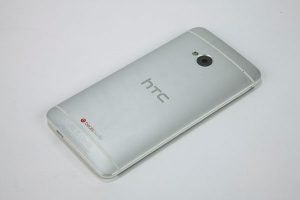
No microSD here
As a higher-end phone, it should come as no surprise that the HTC One has more internal storage. The vast majority of Ones in the UK have 32GB of internal memory, but HTC also makes a 64GB edition. It costs around £700, though.
There are some signs that HTC may start to reintroduce microSD card slots to its top-end phones – there are Japanese and Chinese versions of the phone that have a memory card slot. However, HTC has made no such announcements for the UK.
HTC One vs HTC One Mini – CPU and RAM
HTC One – Snapdragon 600, quad-core 1.7GHz Krait 300, 2GB RAM
HTC One Mini – Snapdragon 400, dual-core 1.4GHz Krait 300, 1GB RAM
There’s a clear divide between the HTC One and the One Mini in pure power terms. Although they use components of the same generation, the HTC One is a much more powerful phone.
They share the same Krait 300-style processor cores, but the Mini has two of them while the One has four. The cores are also clocked at a higher speed in the HTC One, at 1.7GHz against 1.4GHz in the Mini.
Perhaps the most serious component change, in real-life terms, is not the CPU but the GPU. The Mini uses an Adreno 305 chipset while the HTC One has an Adreno 320.

The Areno 305 is significantly less powerful, and gaming performance will be less impressive. This is something that’ll become increasingly evident after a year or so – when developers are coding for much, much more powerful devices.
Another hit to the HTC One Mini’s future-proofing is RAM. It has 1GB, while its bigger brother has 2GB.
HTC One vs HTC One Mini – Connectivity
HTC One – Wi-Fi, NFC, IR, 4G, Bluetooth, GPS
HTC One Mini – Wi-Fi, 4G, Bluetooth, GPS
HTC has made some pretty serious connectivity compromises in the HTC One Mini. It has the basics, like Wi-Fi, GPS and Bluetooth, but several more advanced connections are missing.
There’s no NFC, no IR blaster. What you do get is 4G connectivity, which is becoming standard for any upper-mid range device.
Is the lack of NFC and IR a big problem? For most people it is not. The main function of the IR blaster in the HTC One is to let you use the phone as a universal remote – when reviewing the phone we didn’t find this a huge draw, and it takes a fair bit of setting up.
NFC is potentially more of an issue – it all depends on how big the connection becomes. NFC stands for Near-Field Communication and is a wireless standard that transfers data over pretty short distances.
It’s increasingly being used to sync phones with audio docks, and to transmit files between devices. HTC clearly doesn’t think it’s that important.
There’s another side to NFC too. It can be used to make wireless payments on the high street, but adoption of this is fairly low at present.
Either way, it does mean that the HTC One Mini isn’t particularly future-proofed.
HTC One vs HTC One Mini – Camera
HTC One – 4-megapixel UltraPixel camera, LED flash, OIS
HTC One Mini – 4-megapixel UltraPixel camera, LED flash
With the One, HTC introduced a ‘new’ camera concept – the UltraPixel. It’s a term of HTC’s making, but it relates to something real.
Both the HTC One and HTC One Mini have UltraPixel sensors. They are roughly the same size as a ‘normal’ sensor, but as they feature fewer pixels, the sensor pixels can be much larger than average. This means they can take in more light than average in the same exposure window, resulting in better-than-average low-light performance.
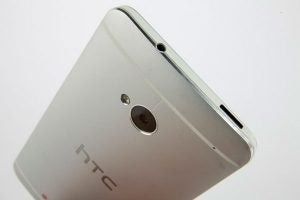
The problem is that – great as it may be – it’s just a 4-megapixel sensor. In good lighting, both the HTC One and One Mini will capture limited photo detail.
The HTC One Mini also lacks optical image stabilisation, found in the One. This will become particularly noticeable when shooting video – where quick movement will appear jagged, rather than fairly smooth as it is in the HTC One.
We’ll be back with a full camera head-to-head soon.
Early Verdict
The HTC One Mini keeps many of the things we like most about the HTC One. Its design is excellent, and while there are some screen compromises, the display remains excellent.
There are cut-backs in almost every other area too, though. CPU, camera, memory and connectivity all suffer a little bit. For this buy to make sense, the HTC One Mini does need to be on sale for significantly less than the HTC One for it to earn our recommendation.
Next, read our top HTC One tips and tricks


